IB Turkestan
Aeroplanes of the Turkestani Military
The Turkestani Air Force and the Guards both use aeroplanes to fulfil their different roles in the Turkestani miltary. These include both propeller aeroplanes and the newer jet aircraft. The main aircraft in use are listed here:
Jet Aircraft:
T-11 Davul
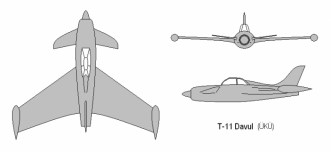
T-11 Davul interceptor
The T-11, named the Davul ("Thunderstorm"), is the newest fighter aeroplane of the Turkestani military. Technically, the aeroplane is still in final testing and production before being introduced, but when introduced, it is expected to supplement the T-9 Boran and the Russian Yan-22.
The Davul is a short-range interceptor aeroplane, faster than the T-9 but without any bomb-carrying capacity. It is planned that the T-11 will see service in both the Air Force and the Guards.
The Davul is a short-range interceptor aeroplane, faster than the T-9 but without any bomb-carrying capacity. It is planned that the T-11 will see service in both the Air Force and the Guards.
The aircraft itself has several features which allow faster flight, including its swept wings and the nose section designed to direct air flow into, rather than around, the engine intake.
T-9 Boran
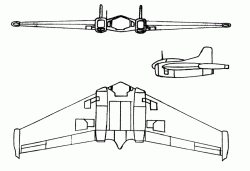
T-9 Boran jet fighter
The Turkestani government announced its intention to build the Boran as a supplement to the Russian Yankov Yan-22 Orel, with the Yan-22 being used in the anti-air/interceptor role by the Guards and the longer-range Boran with the Air Force in a long-range reconnaissance/ground attack/air superiority capacity. Some experts predicted that the Yan-22 will only see service with the Turkestani Air Force for as long as it takes their domestic aeroplane-design industry to produce their own single-engined jet interceptor. The Turkestani-designed T-11 is expected to be introduced soon, but the new interceptor is espected to supplement rather than replace the Russian fighter, at least initially.
The T-9 Boran is an impressive-looking flying wing design with the unique characteristic of having the pilot in a prone position allowing him to withstand greater g-forces. It is expected that this will give the Boran greater manoeuvrability, and hence an edge in aerial dogfights. The prone position also gives the pilot excellent vision of the ground, which is expected to be an asset in bombing and ground attack runs.
Primary armament is a pair of forward-firing 20mm espingol cannon located in the wing outside the engines, for a total of 4 20mm cannon. In addition, due to its flying fuselage configuration the Boran can support four additional weapons mounted on underwing pylons; it is thought that these will be for bombs or attack rockets.
The efficient, low-drag flying wing design and prone pilot position mean that the T-9 can be made smaller than most comparable aircraft, while sacrificing nothing in operational range and very little in weapons load. This makes for a very small target profile, especially from the front or from behind, and this, combined with its manoeuverability, means that the T-9 Boran is a plane to be reckoned with.
Primary armament is a pair of forward-firing 20mm espingol cannon located in the wing outside the engines, for a total of 4 20mm cannon. In addition, due to its flying fuselage configuration the Boran can support four additional weapons mounted on underwing pylons; it is thought that these will be for bombs or attack rockets.
The efficient, low-drag flying wing design and prone pilot position mean that the T-9 can be made smaller than most comparable aircraft, while sacrificing nothing in operational range and very little in weapons load. This makes for a very small target profile, especially from the front or from behind, and this, combined with its manoeuverability, means that the T-9 Boran is a plane to be reckoned with.
Specifications:
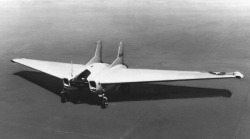
The Boran prototype
Engine: 2x Äşinä R17 axial-flow turbojet engines developing 1150 lb thrust each
Wing-span: 28' 0"
Length: 14' 0"
Height: 7' 0"
Weight: Empty 5840 lb / Loaded 8669 lb
Maximum Speed: 547 mph in level flight
Ceiling: 40,000'
Range: 993 miles (internal fuel), 1360 miles (with drop tanks)
Crew: 1
Armament: 4x 20 mm espingol cannons, 4x underwing hardpoints
Wing-span: 28' 0"
Length: 14' 0"
Height: 7' 0"
Weight: Empty 5840 lb / Loaded 8669 lb
Maximum Speed: 547 mph in level flight
Ceiling: 40,000'
Range: 993 miles (internal fuel), 1360 miles (with drop tanks)
Crew: 1
Armament: 4x 20 mm espingol cannons, 4x underwing hardpoints
Yan-22 Orel
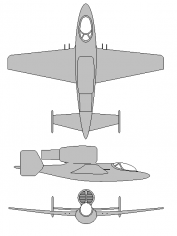
Yan-22 Orel jet fighter
The Yan-22 is a Russian-designed jet fighter introduced in 2004 by the Chelyabinsk-based Yankov design bureau, and is related to the older propeller-driver Yan-2 trainer, rebuilt around the jet engine whose blueprints were stolen from Dalmatian developers during the civil war that put paid to the Confederation of Soviet Danubian States. Its engine-amidships design aids manoeuvrability, but at the expense of the pilot's view to the rear. The danger of a pilot bailing out directly into the jet intake has been averted by the addition of a rocket-assisted ejection seat.
The pro-SNOR Chelyabinsk government and Yankov design bureau gave the name Orel ("Eagle"), an obvious Snorist reference, to the new aeroplane. It has since been sold all over the Russian Federation and to many countries of the former Riga Pact.
The pro-SNOR Chelyabinsk government and Yankov design bureau gave the name Orel ("Eagle"), an obvious Snorist reference, to the new aeroplane. It has since been sold all over the Russian Federation and to many countries of the former Riga Pact.
Propeller Aircraft:
Single-Engined Planes:
T-5 Çağaltaı
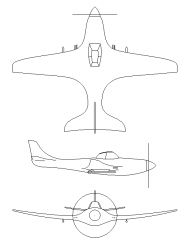
T-5 Çağaltaı fighter
The all-purpose workhorse fighter of the Turkestani Air Force was until recently this nimble little propeller plane. An agile, speedy design from the ÜKÜ stable, it is named after the little Eurasian Hobby, a falcon which regularly takes swallows on the wing.
The Çağaltaı is an aircraft beloved by its pilots, and considered as iconic a piece of Turkestani military hardware as *here*'s British Spitfire fighter of World War 2. Indeed, its role in the air war over Qaşgar was very similar; it was used in airship escort, anti-airship interceptor and air superiority roles.
The aircraft has been relegated to support and training roles by the introduction of jet aeroplanes, and is scheduled to be retired in the next couple of years.
The Çağaltaı is an aircraft beloved by its pilots, and considered as iconic a piece of Turkestani military hardware as *here*'s British Spitfire fighter of World War 2. Indeed, its role in the air war over Qaşgar was very similar; it was used in airship escort, anti-airship interceptor and air superiority roles.
The aircraft has been relegated to support and training roles by the introduction of jet aeroplanes, and is scheduled to be retired in the next couple of years.
Specifications:
Engine: 1x Furaqan-2000 18-cylinder radial propeller engine
Length: 33'-6"
Wingspan: 42'-0"
Height: 13'-10"
Weight: 9,240 lb (empty) 12,500 lb (loaded)
Maximum Speed: 460 mph in level flight
Ceiling: 35,800'
Range: 700 miles
Crew: 1
Armament: 4x 20mm cannon, 2x underwing hardpoints
Length: 33'-6"
Wingspan: 42'-0"
Height: 13'-10"
Weight: 9,240 lb (empty) 12,500 lb (loaded)
Maximum Speed: 460 mph in level flight
Ceiling: 35,800'
Range: 700 miles
Crew: 1
Armament: 4x 20mm cannon, 2x underwing hardpoints
T-8 Büktilgü
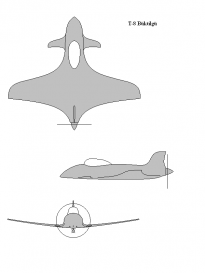
T-8 Büktilgü
The T-8 Büktilgü ("Red-Footed Falcon" Falco vespertinus) is an advanced propeller fighter which was introduced in 1999 just prior to the deployment of the first jet fighters by Dalmatia and the Scandinavian Realm. It is a "tail-first" canard design with a single "pusher" engine, and is in many repects similar to the SR's original Dragen v1 propeller design that formed the basis of the acclaimed Dragen v2 jet fighter.
Building on the success of the T-5 Çagaltai fighter, the ÜKÜ design bureau went on to develop this quite different design in response to an advanced interceptor requirement from the Turkestani Air Force. The T-8 is one of the last front-line propeller fighters to enter service, and has a number of advanced features, including the lightweight composite material used in its construction.
Few T-8s were ever built; their development was subject to cost-cutting force reductions in the post-Qaşgar War drawdown, and though the T-5s felt the brunt of this, the total number of T-8 Büktilgüs delivered fell drastically short of the expected number.
Building on the success of the T-5 Çagaltai fighter, the ÜKÜ design bureau went on to develop this quite different design in response to an advanced interceptor requirement from the Turkestani Air Force. The T-8 is one of the last front-line propeller fighters to enter service, and has a number of advanced features, including the lightweight composite material used in its construction.
Few T-8s were ever built; their development was subject to cost-cutting force reductions in the post-Qaşgar War drawdown, and though the T-5s felt the brunt of this, the total number of T-8 Büktilgüs delivered fell drastically short of the expected number.
Specifications:
Engine: 1x Furaqan "Aydahar" 20-cylinder radial engine
Length: 36'-8"
Wingspan: 38'-8"
Height: 14'-8"
Weight: 7,060lb unloaded, 10,200lb loaded
Max. Speed: 496mph in level flight
Range: 650mi
Ceiling: 35,600'
Crew: 1
Armament: 3x 20mm espingol cannon,1x underwing hardpoints
Length: 36'-8"
Wingspan: 38'-8"
Height: 14'-8"
Weight: 7,060lb unloaded, 10,200lb loaded
Max. Speed: 496mph in level flight
Range: 650mi
Ceiling: 35,600'
Crew: 1
Armament: 3x 20mm espingol cannon,1x underwing hardpoints
Yan-19 Tarpan
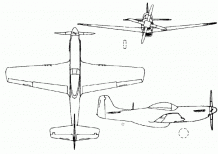
Yan-19 fighter
The Yan-19 fighter is a Russian-designed single-engined propeller aeroplane used by Turkestan in some squadrons, primarily as an airship-carried escort fighter. It is a product of the Yankov aviation development bureau based in Chelyabinsk, and is named after the Tarpan, the Eurasian wild horse formerly prevalent in parts of Ukraine and southern Russia.
Turkestan has never had many of these fighters, although they are excellent aircraft and have been used elsewhere in the Riga Pact in great numbers.
Turkestan has never had many of these fighters, although they are excellent aircraft and have been used elsewhere in the Riga Pact in great numbers.
Multiple-Engined Planes:
T-7 Şıkra
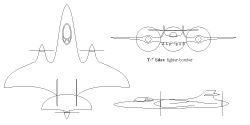
T-7 Şıkra fighter-bomber
The Şıkra (Accipiter badius) fighter-bomber was Märgän Arms' proposal for a longer-range ground-strike aeroplane. A more conventional plane than the rival T-7 proposal from ÜKÜ (the ZT-7Ü Qıran flying wing), it received the blessing of the military procurements bureau and entered service in 1988. Its unusual three-engine configuration - two "pullers" and one "pusher" - leaves the centre-front open for the concentration of weaponry, and its large size enables it to carry quite a weapon load.
LaGG-73
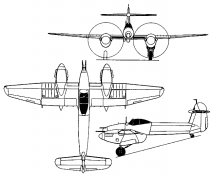
LaGG-73 fighter
The LaGG-73 is a twin-engined fighter from the Lavochkin - Gorbunov - Gudkov aviation design bureau. In Turkestan, it is used in the light bomber, night fighter and medium-range interceptor roles. It is somewhat less capable than some other aeroplanes in the night/all-weather fighter slot, but it is more of a generic design, not so completely built around its radar, than some of that type of aeroplane.
The LaGG-73 is a devastating low-level strike fighter, though, and is able to perform on a par with some of the most advanced single-engine fighters, such as the Yan-19 Tarpan. The Laçın-II engines, however, tend to lose power at altitude, making its operational ceiling lower than many other contemporary aeroplanes.
The LaGG-73 is a devastating low-level strike fighter, though, and is able to perform on a par with some of the most advanced single-engine fighters, such as the Yan-19 Tarpan. The Laçın-II engines, however, tend to lose power at altitude, making its operational ceiling lower than many other contemporary aeroplanes.
Specifications:
Engine: 2x Furaqan Laçın-II 14-cylinder engines
Length: 32'-3"
Wingspan: 45'-0"
Height: 11'-7"
Weight: 8,310lb (empty) 10,356lb (loaded)
Max. Speed: 360mph
Range: 808mi
Ceiling: 30,315'
Crew: 1
Armament: 4x 20mm espingol cannons, 2x bombs (up to 500lb each)
Length: 32'-3"
Wingspan: 45'-0"
Height: 11'-7"
Weight: 8,310lb (empty) 10,356lb (loaded)
Max. Speed: 360mph
Range: 808mi
Ceiling: 30,315'
Crew: 1
Armament: 4x 20mm espingol cannons, 2x bombs (up to 500lb each)
